Peking Duck in Beijing: A Complete Culinary Guide
What is Peking Duck
Also known as Beijing Roasted Duck or Beijing Duck, Peking Duck is one of Beijing's most representative specialty foods. Originally served as imperial cuisine, this Chinese food has now become popular among common people and can be found in various Beijing restaurants. Peking Duck in Chinese is called 北京烤鸭 (Běijīng kǎoyā). If you’re wondering how to pronounce Peking Duck, it sounds like “pay-king duck.”
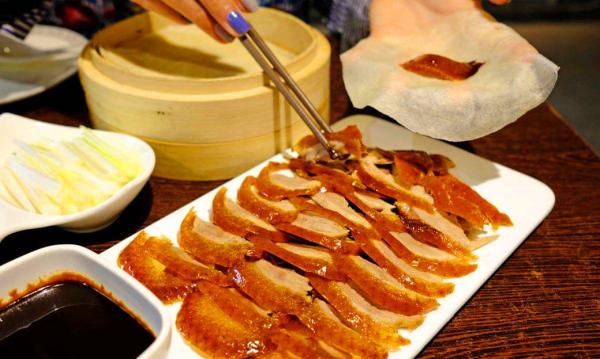
What Kind of Duck is Peking Duck
The ducks used for Peking Duck are the famous Beijing-bred ducks from the Yuquan Mountain area in western Beijing. This type of meat duck is fattened quickly through force-feeding, which increases its fat content and improves the texture of the meat. This breeding method has become the standard for ducks used in Beijing Duck and continues to this day.Peking Duck Origin and History
Where is the Peking Duck from? Although today’s Beijing Roasted Duck is world-famous, its origins trace back to Nanjing, the capital of China during the Southern and Northern Dynasties.
It developed significantly when Ming Dynasty imperial chefs in Nanjing created the "Jinling Roast Duck" (a popular Nanjing food until today) by using local lake ducks and charcoal fire roasting. After Emperor Zhu Di moved the capital to Beijing, Nanjing's roast duck techniques were introduced to the new capital, where special Beijing ducks were bred for optimal roasting. During Emperor Jiajing's reign, Beijing's first roast duck restaurant, Bianyifang, was established, creating the "closed-oven roasting" method that marked the beginning of Peking Duck.
In Emperor Qianlong’s era, a Shandong-born imperial chef refined the roast duck dining experience by wrapping duck slices with crisp cucumbers, fresh scallions, and Beijing's signature sweet sauce in delicate pancakes. Later, this eating method spread among common people, forming a distinctive Beijing-style feature. In 1864, Quanjude Roast Duck Restaurant was established, inventing the hung-oven roasting technique, which, combined with the imperial Peking Duck serving traditions, formally established the standard for modern Beijing Duck.
Why Is It Called Peking Duck
This dish is made from ducks raised in Beijing and has long been a favorite in the Ming and Qing imperial courts. Gradually, it was officially named Peking Duck. Try it during your China food tours to Beijing, and you’ll understand why the royal families like it.
>> Recommended 5-day Beijing food tourPecking Duck Components
Skin
The best part of a Peking Duck is the crispy skin, especially from the breast. After prolonged fruitwood roasting, the skin becomes delightfully crisp with rich yet non-greasy fat. The magic happens when thick, fat layers render down. Thin fat simply can't achieve this - it just turns chewy.
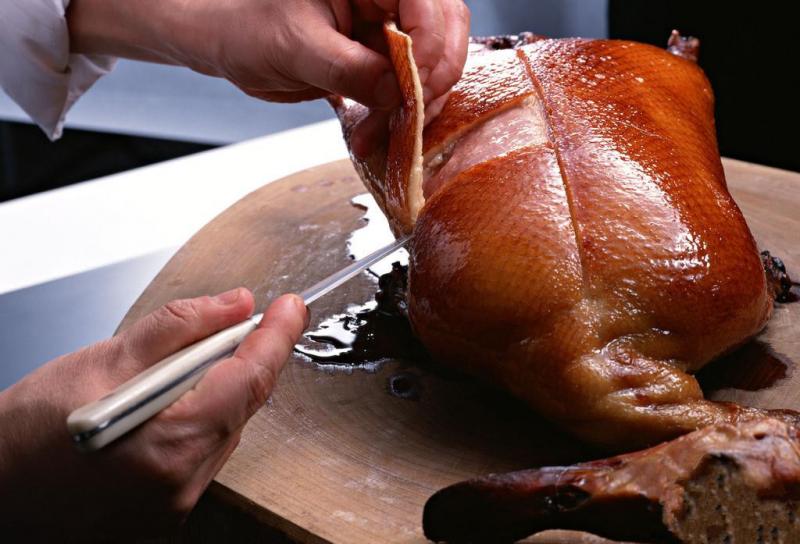
Meat
Peking Duck meat is tender and flavorful. Good slices include both skin and meat at the perfect thickness. The breast is soft with balanced fat, never greasy, while the leg is firmer and springy, with a rich, savory aroma.Bones
Don’t discard those leftover Peking Duck bones—they’re a culinary treasure! The bones are broken into pieces and stir-fried to render out fat, then seasoned with pepper salt, cumin, and chili for a perfect beer-time snack. Or, simmer them into a soul-warming broth that captures every last drop of roasted goodness.Pancakes
Pancakes are the best companions for Beijing Roasted Duck. They are far more than mere duck wrappers for duck meat. Their cloud-soft texture and gentle wheat balance the duck’s richness and contrast nicely with the crispy skin and juicy meat.Hoisin
Hoisin is the classic dipping sauce for Peking Duck, whose unique sweet-salty flavor significantly enhances the taste of the duck. Made primarily from fermented soybeans and flour, this rich condiment perfectly elevates the duck's natural flavors while gracefully eliminating any undesirable odors.Accompaniments
Beijing Duck is typically served with side ingredients like cucumber strips and shredded scallions. The cucumber keeps it light, and the scallions add a touch of spiciness.How to Eat Peking Duck
Classic Way to Enjoy Peking Duck: Wrapped in Pancakes
Eating Beijing Roasted Duck in this way, simply use chopsticks to dip a slice of roast duck in a bit of hoisin or Beijing Duck sauce and spread it on a warm pancake, add slices of duck, and top with shredded scallions and cucumber. Roll it up like a spring roll—and savor the classic taste of Beijing.
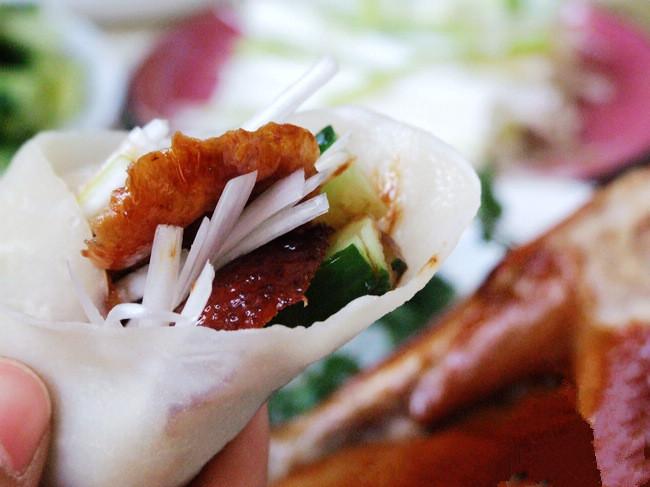
Elegant Way: Dip Crispy Duck Skin in Sugar
For some ladies and children who don’t like strong flavors or eating too much meat but still want to taste the flavor of Peking Duck, you can dip the sliced crispy duck skin in white sugar. It has a special taste that is sweet, crispy, and leaves a pleasant fragrance in your mouth.Creative Way: Enjoy with Garlic Paste
Prepare a small dish of garlic paste, then use chopsticks to pick up a slice of duck meat (without skin) and dip it in. This method preserves the duck's original aroma—tender and free of gaminess.Trendy Way: Peking Duck with Plum Sauce
A new way to eat Peking Duck is with Beijing’s signature crabapple plum sauce. Dip a few slices of duck in the sauce, add Hami melon and cucumber strips, then wrap it all up. It tastes refreshing and fruity, and perfectly offsets the duck’s richness.Pro Tips
- Remember to eat the Peking Duck while it’s still hot. If it cools down, the skin loses its crunch.
- When wrapping the duck meat in the pancake, don’t overfill it, or it’ll be hard to roll and less enjoyable.
- You can adjust the scallions and cucumber to your taste—use less or skip scallions, and add chili if you like it spicy.
Roast Duck Restaurants in Beijing: Where to Eat Peking Duck
Since it’s the No.1 Chinese food in Beijing, the city’s bustling streets are lined with Peking Duck restaurants. Quanjude is the most famous one, serving the “Whole Duck Banquet” and hundreds of duck dishes. Its duck is glossy, crisp on the outside, and tender within. Bianyifang stands out for its “four removals” method — removing oil, fat, acidity, and odor — to create crisp yet juicy duck. Siji Minfu, especially the branch near the Forbidden City, is popular among young diners for its fragrant duck and great view of the city’s moat and towers.
>> Recommended 10-day taste of China’s top cuisines including Peking Duck
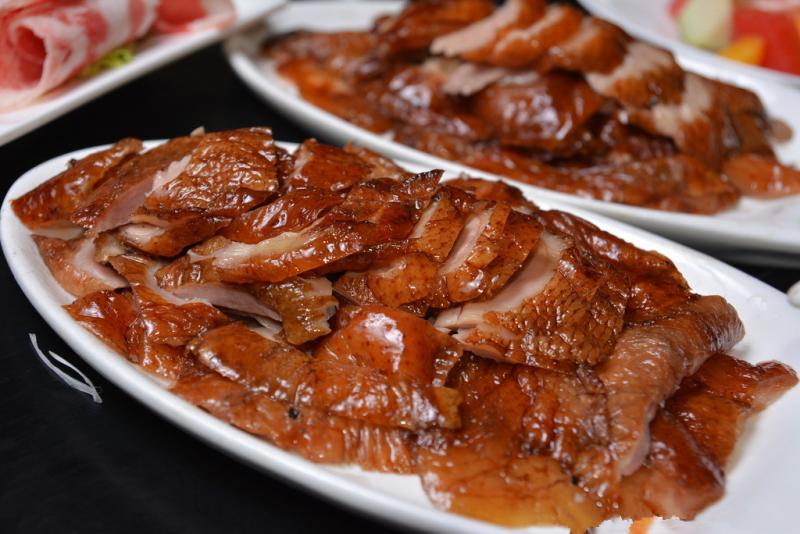
How to Order and Serve Peking Duck
How to Order
It’s so popular to eat Peking Duck in Beijing that most famous restaurants have long queues. To save time for your Beijing tours, you can reserve by using WeChat mini programs, Meituan, or the Dianping apps. As for the Peking Duck price, it varies, but most often it costs around 200–300 RMB per duck.
For one or two diners, half a Peking Duck with pancakes, condiments, and zhajiangmian is ideal. If you’re dining with four or more people, order a whole Peking Duck along with a few signature dishes. Larger groups can try a full duck feast featuring duck heart, liver, and tongue.How to Serve
Choose your preferred serving style, and you can eat Peking Duck with steamed buns or traditional pancakes. Then, watch the chef slice the duck right in front of you. Restaurants like Quanjude insist on slicing the duck into exactly 108 pieces, each with skin and meat evenly attached. The slicing technique is so exquisite that the finished dish looks like a piece of art. Don’t forget to take some photos of Peking Duck! Once the duck is sliced, it’s time to eat!
Peking Duck Nutrition
You may wonder if Peking Duck is healthy. In fact, Peking duck not only conquers diners’ taste buds with its unique flavor but is also highly regarded for its rich nutritional value.Each 100 grams of duck meat provides around 20% high-quality protein—enough to cover a quarter of an adult’s daily needs. The fat in the duck slices is about 22%, resulting in an ideal balance between protein and fat. Also, it contains a variety of inorganic salts and trace elements like calcium and iron. In addition, it's rich in fat-soluble vitamins like A and E; just 100 grams of duck can supply about 20% of your daily vitamin E needs. So, eating Peking Duck in moderation is healthy, and don’t hesitate to try it on your Beijing tours!
>> Explore more Healthy Chinese Food to Eat
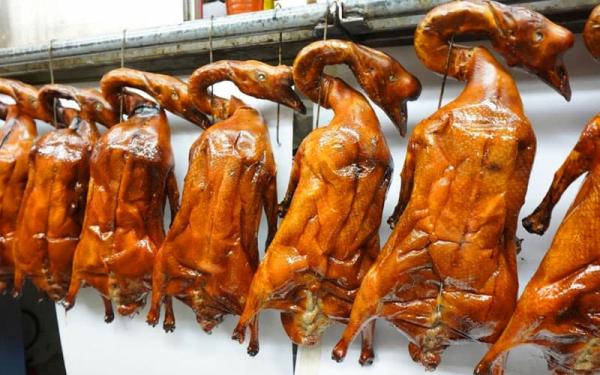
Peking Duck Recipe: How to Make Beijing Roast Duck
Wondering how Peking Duck is made and want to try it yourself? There are various ways to make Peking Duck at home. Here’s a typical recipe.Ingredients for Peking Duck
Instructions for Peking Duck
Step 1: Clean the duck, pour boiling water over it to tighten the skin, and then leave it air dry.
Step 2: Apply Peking Duck seasonings, including salt, five-spice powder, cooking wine, and light soy sauce, to marinate. Rub inside the duck cavity.
Step 3: Mix honey, vinegar, and water to create the crispy glaze, and brush over the duck skin. Once it’s scorched, brush another layer.
Step 4: Preheat your oven to 180°C. Afterward, place the duck breast-up on a rack (or stand it up using a beer bottle) with a pan underneath to catch drippings, and roast for 40 minutes. Again, brush with glaze, and turn the oven to 200°C, and roast for another 20 minutes until its skin turns golden and crisp.
Step 5: Slice the duck—the crispy skin first, then move on to the tender meat.
Your delicious Peking Duck is ready. Get the pancakes, cucumbers, scallions, and hoisin sauce, and enjoy!